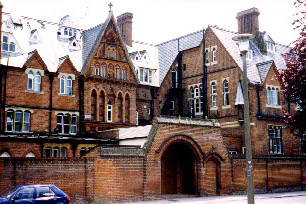 |
 |
Hatch Lane, Windsor |
Index |
of Windsor |
In the intervening years the Convent has been converted into apartments. Some are a true delight, retaining the windows and fireplaces of the original building. A large development of flats on the northern side retains the overall architectural theme of the original buildings, though we have no knowledge of their interiors. Perhaps some residents would like to let us know how they find them In May 2001 plans were well advanced for the sale of the Convent, with the Sisters moving to a 400 year old priory near Oxford. We extend our thanks for the work they have undertaken in this community for the last 150 years. There is a web site here. The Community of St. John the Baptist, Begbroke, Kidlington By October 2004 it is understood that the Convent has again changed hands though it is now less clear what will actually happen to the buildings, although it is virtually certain that the chapel and the bulk of the existing buildings will be retained. A comprehensive history of the Convent has been written in three volumes by Valerie Bonham. These are available from the Community as above. A
Joyous Service A
Place in Life Sisters
of the Raj |
This article was written in 1999 before their move was announced.

No-one who has passed by The Convent in Hatch Lane can fail to have been impressed by its size, and wondered about the work and daily routines of the Sisters who live there. There are two things that this writer is certain of, one, that over the years since its inception in early Victorian times much valuable help and shelter has been afforded to girls who might otherwise have totally despaired of the situation they found themselves in, and, two, that the buildings themselves are impressive examples of the Victorian style. The Chapel interior is quite splendid!

In the 1980s and 1990s, Valerie Bonham
meticulously researched the history of the Convent. The result
was been three excellent books. The first, 'A Joyous Service', subtitled 'The Clewer
Sisters and Their Work' admirably answers the question raised
at the top of this article about the life and work of the Clewer
Sisters. Queen Victoria herself paid a private visit in 1864
and recorded the event in her journal. She was favourably impressed.
The Prime Minister, William Gladstone, also took an interest
in the work as well as other well-known personalities of the
day.
Valerie Bonham's second book, 'A Place in Life', chronicled the history
of the 'Clewer House of Mercy' through the period 1849-1883.
Much fascinating detail is included about the construction of
the Convent together with the people involved from its inception
to completion. Harriet Monsell is the focal point of the book
for she. with great strength of character, firmness of faith
and an infectious sense of humour, plus her gift for listening
and her irresistible magnetism, was one of the greatest women
of her day.
The final book, 'Sisters
of the Raj', is devoted to the work undertaken in India by
the Clewer Sisters. Once again a thoroughly detailed and revealing
history written in very approachable style, not in the least
academic or heavy going. Following a government invitation in
1881, three Sisters left for India to organise nursing in a Calcutta
hospital. Over a period of 64 years, some 100 Sisters were to
work in India. Sr Jane Frances, the granddaughter of a Scottish
Earl and relative of the Duke of Argyle, was to lead the Sisters
for 30 years and at her death, the Bengali people were deeply
grieved. It is her story, and those of the other Sisters who
went to work in India, that this book is about. The backcloth
is the British Raj, and the main players are the Sisters and
those with whom they lived and worked. The grand theme, however,
is India!
All three books are very much recommended. It would
be a mistake to assume that these are purely religious tomes.
On the contrary, they represent a valuable and accurate insight
into the ways of the world and society across more than a century
and a half, and as such will be enjoyed by a wide readership.
It is sad therefore that in 1999 (Observer, 23rd
July 1999) the papers carried stories about the diminishing numbers
of Sisters to carry on this tradition and the difficulty in maintaining
the Community. Perhaps in some ways one should be reassured that
the needs of Victorian society that brought about the existence
of the Community in the first place are no longer so essential,
and that government and society has moved into a more enlightened
age with the advent of the Welfare State and similar social developments.
On the other hand, it is dispiriting to think that financial
influences can threaten such a long established part of Windsor's
society.
To contact us, email Thamesweb. |